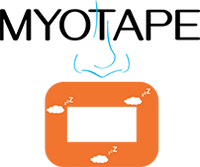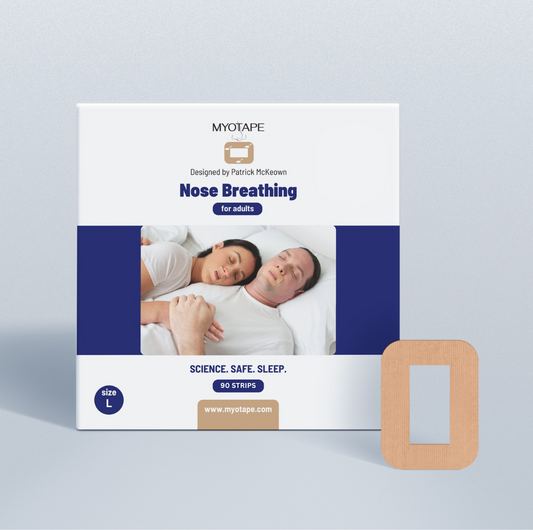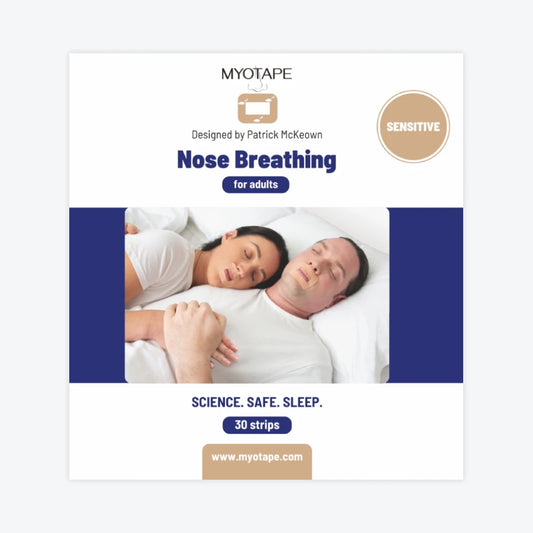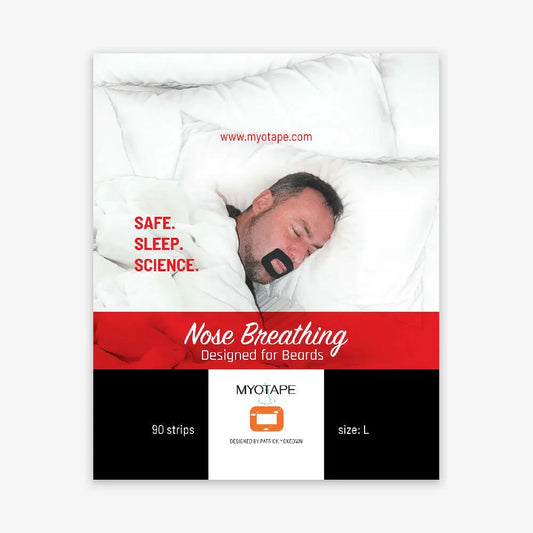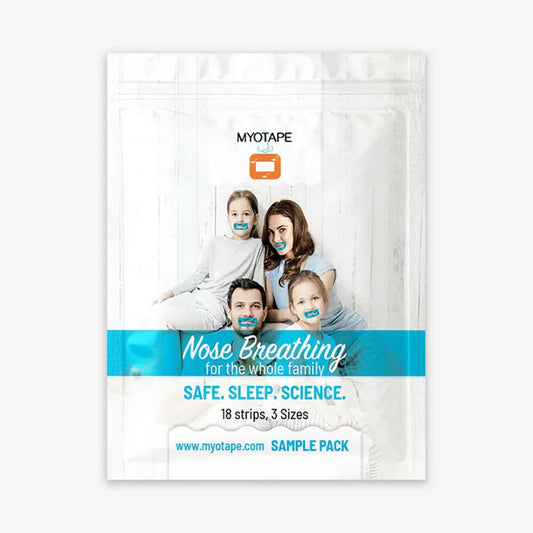Mouth taping has quickly become a popular way to encourage nasal breathing and improve sleep quality. People use it hoping to snore less, wake up feeling more refreshed, and support better overall health.
But what happens when your nose feels stuffy or blocked? Can you still use mouth tape if you can’t breathe clearly through your nose, or could that actually make things worse?
It’s a common question, especially during allergy season or when you’re fighting off a cold. Many people are unsure whether mouth taping is safe when their noses are congested.
In this article, we’ll explain what really happens when you mouth tape with a blocked nose, whether it’s safe, and how to make sure you’re breathing comfortably at night.
What Mouth Taping Is and Why It’s Popular
Mouth taping is a simple practice where a small strip of gentle adhesive tape is placed around your lips to help keep your mouth closed while you sleep.
The main goal is to encourage nasal breathing, which supports better sleep, improved oxygen intake, and overall health.
By keeping your mouth closed, mouth taping helps reduce snoring, dry mouth, and restless sleep caused by mouth breathing.
Research has shown that even habitual mouth breathers can comfortably breathe through their noses when their mouths are gently taped, proving how effective nasal breathing can be.
Why Nasal Breathing Matters
- The nose filters and humidifies air, protecting your lungs
- Boosts nitric oxide production, improving blood flow and immunity
- Supports better oxygen intake and overall health
Because mouth taping works best when your nose is clear, it’s important to understand what happens if you try it while congested, which we’ll explore next.
Can You Use Mouth Tape with a Stuffy Nose?
It is not advisable to tape your entire mouth shut when your nose is stuffy or blocked, especially when you use conventional mouth tapes that completely cover the mouth.
Using a mouth tape allows for emergency opening when you have a stuffy nose. like MyoTape is a lot safer and more effective.
Completely covering the mouth when you have a stuffy nose or blocked nose can make breathing difficult and uncomfortable because airflow through your nasal passages is restricted, which makes MyoTape safer.
When your nose is congested, your body automatically switches to mouth breathing to get enough air, but if your mouth is taped, this can cause air hunger, anxiety, and poor sleep.
If your nose feels blocked, it’s best to wait until it’s clear or do the nose-unblocking exercise before using mouth tape again.
Also, note that nasal congestion can occur for many reasons, including allergies, sinus infections, asthma, or structural issues such as a deviated septum.
Children often experience nasal blockage due to enlarged adenoids or tonsils, while adults may deal with chronic sinus inflammation or nasal polyps.
In some cases, such as a severely deviated septum or enlarged adenoids, surgery may be needed to restore proper airflow before mouth taping can be safely used.
For most people, however, gentle breathing exercises, nasal rinses, and improved breathing habits can help reduce congestion naturally and make nasal breathing while sleeping or easier over time.

Is It Safe to Mouth Tape When You’re Congested or Sick?
It is not safe to entirely tape your mouth when you’re congested, sick, or struggling with nasal blockage.
When you have a cold, sinus infection, or allergies, inflammation narrows your nasal passages and makes it harder to breathe through your nose.
If you tape your mouth in this condition, you may feel short of breath, anxious, or wake up gasping for air, which would increase discomfort.
People with asthma, sinus congestion, or chronic rhinitis should also take extra care, as inflammation in the nose can easily affect the lungs.
However, mouth breathing during illness can dry out your airways, worsen irritation, and slow recovery. So, it is generally safe to use MyoTape because it encourages mouth closure while allowing for urgent mouth opening.
Always remember that breathing safely and comfortably comes before any sleep or breathing technique.
If you’re not able to breathe clearly through your nose, skip the tape until you can.
How to Mouth Tape Safely for Nasal Breathing
If you’re wondering how to mouth tape with a stuffy or blocked nose, the key is to make sure your nasal breathing feels easy and natural before you start.
Here are simple and safe ways to prepare your body for mouth taping:
1. Clear your nose with the Buteyko Unblocking Exercise
If you have a stuffy nose and want to mouth tape, you can perform this Buteyko exercise to decongest the nose:
- Sit upright and relax your shoulders.
- Breathe in gently through your nose and out through your nose.
- After exhaling, pinch your nose and hold your breath.
- Gently nod your head or sway until you feel a strong need for air.
- Release your nose and breathe in calmly through your nose again.
- Repeat this exercise up to six times before bed.
This quick exercise helps open nasal passages naturally and makes nasal breathing easier.
2. Use MyoTape for safe and comfortable mouth taping
MyoTape is designed specifically to encourage nasal breathing safely without fully sealing your mouth shut.
Compared to conventional tapes, MyoTape wraps gently around the lips, leaving the center of your mouth free so you can open it if needed.
This makes it a safe, comfortable, and effective solution for anyone new to mouth taping or concerned about airflow.
Its soft, skin-friendly elastic provides a gentle reminder to keep your mouth closed, helping you maintain nasal breathing throughout the night.
3. Try a nasal dilator
If your nose tends to feel blocked at night, consider using a nasal dilator.
This small device fits inside your nostrils to gently widen your nasal passages and improve airflow while you sleep.
It can be used alongside MyoTape for even better results.
4. Clear your nasal passages before bed
Before applying tape, use a saline rinse, warm steam, or nasal strips to clear any congestion.
Clean nasal passages make it easier to breathe comfortably and reduce the risk of dryness or blockage overnight.
5. Talk to a medical professional
If you experience chronic congestion, allergies, or breathing issues, consult your healthcare provider before using mouth tape regularly.
They can help identify underlying causes and recommend the best approach to safely improve nasal breathing.
Following these mouth taping tips for a blocked nose will create a safe, effective routine that supports nasal breathing, better sleep, and overall health.
Choose MyoTape to Breathe Better & Sleep Better
Better breathing starts with breathing through the nose at all times, while still being able to breathe safely and comfortably.
MyoTape, created by breathing expert Patrick McKeown, is designed to encourage nasal breathing without sealing your mouth shut, making it safe even if your nose occasionally feels stuffy.
Its soft, skin-friendly design surrounds your lips instead of covering them, allowing easy airflow and peace of mind while you sleep.
Go to the MyoTape online shop, and select from a variety of options designed for everyone, including mouth tape for kids, mouth tape for adults, mouth tape for sensitive skin, and mouth tape for beards.
